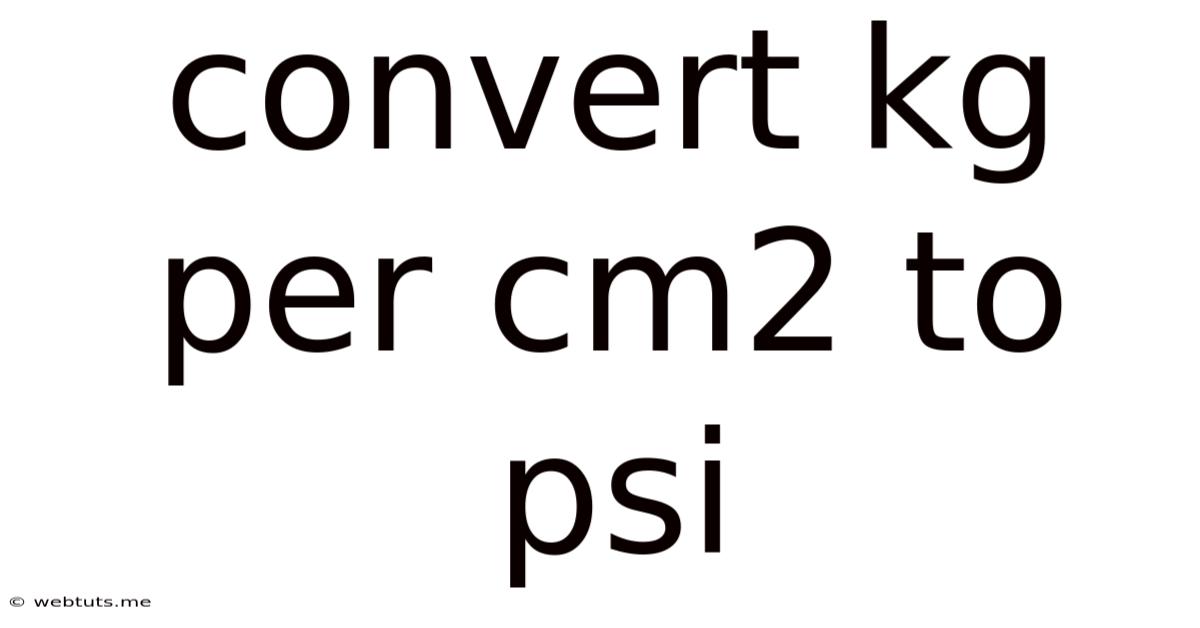Convert Kg Per Cm2 To Psi
Webtuts
May 13, 2025 · 4 min read

Table of Contents
Converting kg/cm² to psi: A Comprehensive Guide
Converting units is a fundamental task in many fields, from engineering and physics to everyday life. This comprehensive guide will delve into the process of converting kilograms per square centimeter (kg/cm²) to pounds per square inch (psi), providing a thorough understanding of the conversion process, its applications, and helpful tips to avoid common errors.
Understanding the Units
Before diving into the conversion, let's understand the units involved:
Kilograms per Square Centimeter (kg/cm²)
This unit represents pressure. It indicates the force exerted in kilograms on an area of one square centimeter. It's commonly used in various parts of the world, particularly in those regions that primarily use the metric system.
Pounds per Square Inch (psi)
This unit, prevalent in the United States and other countries using the imperial system, also signifies pressure. It measures the force exerted in pounds on an area of one square inch. Psi is widely used in various applications, including tire pressure, hydraulic systems, and industrial processes.
The Conversion Formula: kg/cm² to psi
The conversion from kg/cm² to psi involves a multi-step process. It's not a simple direct conversion because it necessitates converting both mass (kilograms to pounds) and area (square centimeters to square inches).
The formula is:
psi = kg/cm² * 14.2233
This formula incorporates the conversion factors for kilograms to pounds (approximately 2.20462 lbs/kg) and square centimeters to square inches (approximately 0.155 sq in/cm²). These factors are combined to yield the single conversion factor of roughly 14.2233.
Step-by-Step Conversion Process
Let's illustrate the conversion process with an example. Suppose you have a pressure of 10 kg/cm². To convert this to psi, follow these steps:
1. Identify the Value:
You have a pressure value of 10 kg/cm².
2. Apply the Conversion Factor:
Multiply the kg/cm² value by the conversion factor:
10 kg/cm² * 14.2233 ≈ 142.23 psi
3. State the Result:
Therefore, a pressure of 10 kg/cm² is approximately equal to 142.23 psi.
Practical Applications of the Conversion
Understanding this conversion is crucial in various fields:
Engineering and Manufacturing
Engineers often encounter pressure measurements in different units, necessitating conversions for accurate calculations and design specifications. For instance, when designing hydraulic systems, converting between kg/cm² and psi is crucial to ensure compatibility with different components and standards.
Automotive Industry
Tire pressure is commonly expressed in psi, but pressure gauges in some regions may display readings in kg/cm². Converting between these units is essential to maintain the correct tire inflation for optimal performance and safety.
Industrial Processes
Many industrial processes involve pressure regulation and monitoring. Accurate conversion between kg/cm² and psi is necessary for proper operation and safety protocols. This is especially critical in high-pressure applications.
Scientific Research
Scientists working with fluids and gases may encounter pressure data in various units, requiring them to perform conversions for data analysis and comparison. This ensures consistency and facilitates accurate interpretation of results.
Common Mistakes and How to Avoid Them
Several common mistakes can occur when converting kg/cm² to psi. Here are some to watch out for:
- Incorrect Conversion Factor: Using an incorrect or outdated conversion factor is a major source of error. Always use a reliable source for the conversion factor (14.2233 is a widely accepted approximation).
- Unit Confusion: Double-check that you are working with kg/cm² and not a similar unit, such as kg/m². A simple mistake in the unit can lead to a significant error in the conversion.
- Calculation Errors: Simple mathematical errors can easily occur. Use a calculator to double-check your calculations, particularly when dealing with multiple decimal places.
- Rounding Errors: Excessive rounding can lead to accumulating errors. Avoid excessive rounding until the final result is obtained. Maintain sufficient decimal places during intermediate calculations for accuracy.
Advanced Considerations and Beyond the Basics
While the basic conversion formula provides a good approximation, for highly precise calculations, it's crucial to understand that the conversion factor 14.2233 is an approximation. The precise value depends on the units used for gravity and the precise definition of the pound.
For applications demanding extremely high precision, it's recommended to use a more rigorous calculation incorporating the fundamental definitions of the units involved. This often involves considering the specific gravitational acceleration (g) applied in the measurement.
In addition to direct conversions, it's also beneficial to understand the relationship between other pressure units, such as Pascals (Pa), atmospheres (atm), bars, and millimeters of mercury (mmHg). Understanding the relationships between these units will enhance the ability to tackle various unit conversion challenges efficiently.
Conclusion: Mastering kg/cm² to psi Conversion
The conversion of kg/cm² to psi is an essential skill across various fields. By understanding the underlying principles, the step-by-step conversion process, and common pitfalls, you can confidently perform this conversion accurately. This guide provides a solid foundation for efficient and accurate unit conversions, ensuring data integrity and supporting precise engineering and scientific calculations. Remember to always double-check your work and use reliable resources for the conversion factor to avoid errors. Understanding the context of the pressure measurement and the level of precision required will guide your selection of appropriate conversion methods. With practice, this essential conversion will become second nature.
Latest Posts
Latest Posts
-
What Is 2000 Seconds In Minutes
May 14, 2025
-
How Many Teaspoons Are In Two Ounces
May 14, 2025
-
90 Days From November 22 2023
May 14, 2025
-
180 Days From June 24 2024
May 14, 2025
-
90 Days From October 17 2023
May 14, 2025
Related Post
Thank you for visiting our website which covers about Convert Kg Per Cm2 To Psi . We hope the information provided has been useful to you. Feel free to contact us if you have any questions or need further assistance. See you next time and don't miss to bookmark.